|
HMS Illustrious
was the first aircraft carrier in the Royal Navy to have an armoured
flight deck. All previous designs had wooden decking.
She was used to ferry Spitfires to Malta. During such a convoy called
Operation Excess she was badly damaged & had to make for Malta on
the 10th January 1941 at 10pm to undergo emergency repairs. An account
of this convoy can be seen by clicking the link in the left column.
This was not the safest place to be as the German bomber pilots were
instructed to 'sink Illustrious'
& consider it a prime target. Being laid up in harbour made her
a sitting duck for the bombers & every effort was concentrated on
her by the Axis bombers.
On arrival in Grand Harbour she was berthed at Parlatorio Wharf in French
Creek. The dead & injured were taken ashore with the wounded being
taken to Mtarfa hospital. Work progressed on repairs round the clock.
The Engineer Commander said 'Her engines are
not too bad, we'll get her away alright'. Maltese workmen
were instructed not to repair the flight deck but to concentrate repairs
on bare essentials to make the ship seaworthy.
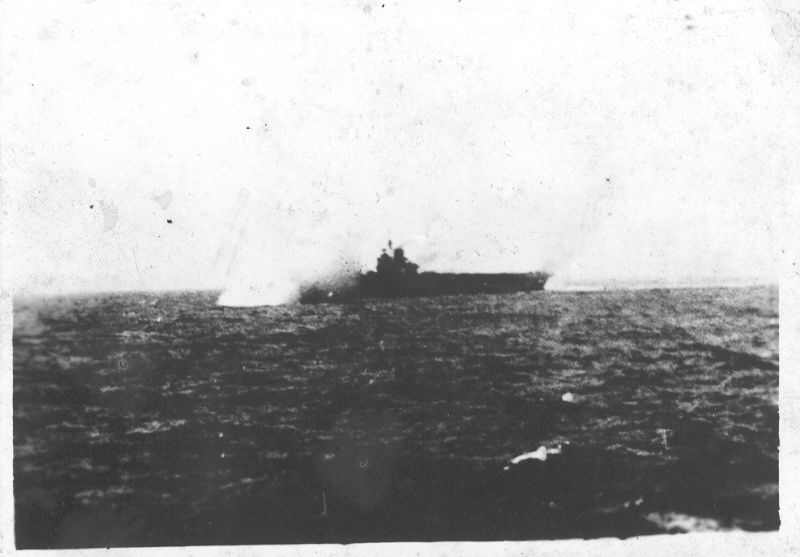
HMS Illustrious
under attack July 1941
Photo courtesy of Tony Cox.
Log
| 10th
January 1941 |
Attacked some 85 miles west of Malta
by 40 Stukas from the newly arrived Fliegerkorps X. In a well
planned attack lasting an hour. In this attack 1.000 pound pound
bombs were used. The design of Illustrious
was said to be capable of withstanding only 500 lb bombs. Before
the bombing the squadron of Fulmars managed to get off.
After this attack Illustrious went round in circles. The flags
sent out the message 'I am not under control'.
The 2 lifts each weighing some 300 tons were wrecked & welded
into different shapes by the white hot fires which raged below
deck. Fires were now a main priority to extinguish before the
ship which carried high octane fuel & ammunition caught
light. The power at one stage failed & the pumps were put
out of action.
The Luftwaffe returned after refueling & rearming in Sicily
to give the final blow. The fleet went to Illustrious' aid &
put up a heavy barrage. Fulmars from Illustrious fought to save
the ship & retired to Malta to refuel & rearm to again
return to the fight & shoot down at least 5 Stukas. She
was still 40 miles from Malta.
The boilers were still untouched but the stokers were working
in temperatures of 130°F. A shell splinter had jammed the
sprinkler system full on which was flooding the ship.
Another attack by the Luftwaffe saw another 1,000 pound bomb
hit the ship. This bomb penetrated a damaged lift shaft &
reignited the fires.
It took the ship 5 hours from this last attack to make Grand
Harbour.
Arrived Malta at 10 o'clock in the evening.
The arrival of such an important ship
brought a lot of civilian onlookers who crowded the harbour
area. At a quarter past noon on the 16th January an announcement
was made over loudspeakers to the civilians to make for air
raid shelters on hearing the air raid sirens as a new defence
strategy was to be used to protect the harbour & flying
shrapnel from exploding shellls falling from the sky would make
the area very dangerous. Many civilians at this time would stay
above ground to watch the bombing.
At 13.55 the radar picked up a large contact - 'It
was the largest that had ever been recorded in Malta till then'.
The harbour guns lifted to their fixed positions - light AA,
heavy AA, 4·5" guns, pom poms, machine guns &
even heavy guns on the fort not used as they could not reach
high levels were brought to bear against the lower flying dive
bombers.
The bombers from Fligerkorps X were escorted by Messerschitt,
Fiat & Macchi fighters. The RAF managed to send up 4 Hurricanes,
3 Fulmars & 2 Gladiators. These were instructed to stay
out of the harbour area & pick off stragglers. The attack
comprised of 2 seperate attacks - the first by Ju 88's (shallow
dive bombers) & the second by Ju 87 (Stuka's). This force
amounted to 70 bombers all concentrating on sinking Illustrious.
The harbour guns opened up to a deafening noise described as
'hell let loose'. The ships
in harbour including Illustrious
fired their guns also.
Despite the bravery of the German airmen only one bomb hit Illustrious
this being on the quarterdeck & caused little damage.
Despite the RAF pilots being told not to enter the harbour area
a Fulmar chased a Stuka right through the barrage. After the
bomber released his bombs he swept off down the harbour so low
to the water he had to climb to get over the 15' breakwater.
The Fulmar eventually shot it down. This returned to Hal Far
where the pilot remarked - 'Don't think
much of Malta's bloody barrage'. The plane however
was so badly damaged it didn't fly again apparently.
During this attack the merchantman Essex
which was lying at the other end of the creek was hit by a heavy
bomb in the engine room with the loss of 38 men. Luckily the
bulkheads contained the explosion. She was loaded with 4,000
tons of ammunition & torpedoes.
On the 19th January came the last bombing raid which raised
up clouds of dust to 1,000 feet. This probably screened the
ship was accurate bombing.
Illustrious left Malta at
sunset on the 23rd qickly accelerating to 20 knots on leaving
harbour for a 2 day trip to Alexandria.
Later she would travel to the USA for repairs & later return
to Malta for Operation Husky the invasion of Sicily in 1943.
|
| Operation Husky |
|
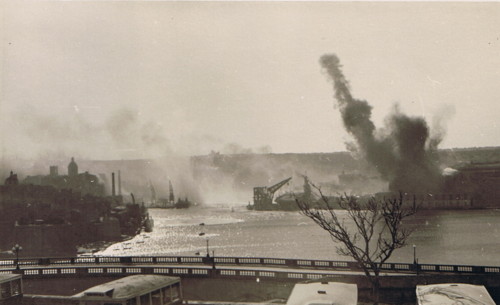 |
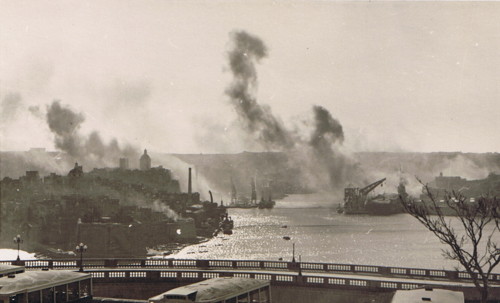 |
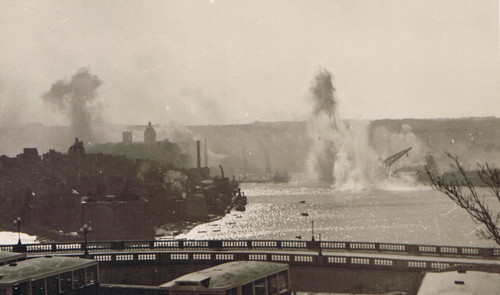 |
The Bombing
of HMS Illustrious.
This set of 3 photos shows the bombing
of HMS Illustrious in Grand
Harbour, Malta 1941. The ship can be seen under the crane centre
& to the right.
I had the first photo in my fathers collection. This was also
sent in by Tony Cox. The complete set was kindly sent to me
by Keith Bastard.
The dockyard floating crane was positioned
over the flight deck to prevent low level attacks.
What you can't see in these photos is the submarine HMS
Upholder which was berthed some 50 feet astern of
Illustrious.
See also the Floating Crane page.
|
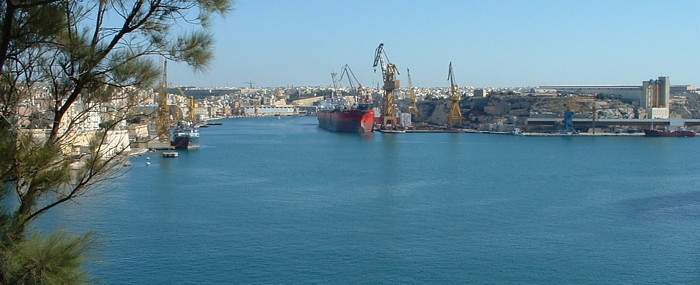
Photo taken in 2006. HMS
Illustrious was moored about where the tall yellow crane
is in this photo.
Photos above were taken a little to the left.
|
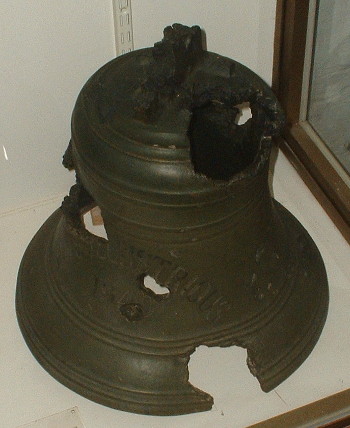
Bell of the Illustrious currently in
the Malta National War Museum
|
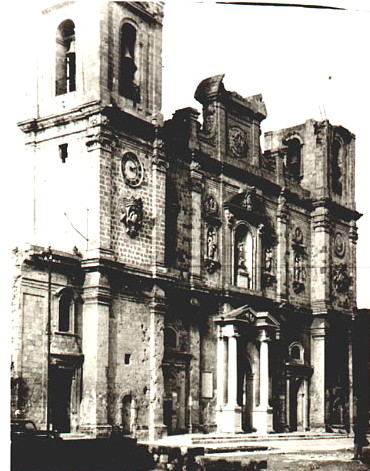
Senglea Church or what's
left of it after it was hit during the attack on HMS
Illustrious on 16th January 1941.
Photo courtesy of Victor Pulis.
|
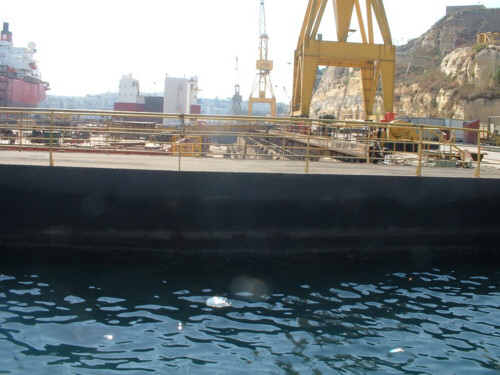
Parlatorio Wharf where Illustrious
was brought for repairs. Now it's a huge dry dock area capable of
taking super tankers. Taken in 2006.
Illustrious
was bombed about where that big yellow crane is standing.
I talked to a Maltese friend in 2006
& was amazed to hear that his father worked in the docks as a
ship repairer. He remembers his father talking about working on a
ship & that ship suddenly moving without taking the mooring ropes
off. These broke off & the labourers were part of the ships company.
Reports also suggest the Illustrious
left at great haste the second repairs to make her seaworthy were
completed. She did leave without casting off mooring ropes as reports
state ropes hanging from Illustrious
on exit from harbour. Could this be the same ship?
During this raid 5 aircraft
were shot down by fighters & 5 by the anti-aircraft guns. Many
escaped the scene badly damaged.
Another raid was mounted on the 18th but this time the target for
the bombers were the airfields of Luqa & Hal Far. The thinking
being that if the RAF was knocked out another raid on Illustrious
would be successful. Hal Far was so badly hit as to be unserviceable.
During this raid 7 aircraft were shot down by fighters & 4 to
the AA guns.
On the 19th a last raid was mounted on Illustrious.
To meet them were 6 Hurricanes. 1 Fulmar & 1 Gladiator which
shot down 11 aircraft. The AA guns shot down a further 8. This was
estimated to be about a quarter of the attacking force. During this
raid the ship received no direct hits but near misses exploding
on the sea bed caused underwater damage.
A further attack was planned in Sicily but on the night of the 23rd
Illustrious sailed out of the
harbour bound for the safety of Alexandria. She was able to make
20 knots & moved so fast she missed her escort cruiser squadron
which were heavily bombed.
Illustrious received further
repairs before setting sail for Norfolk, Virginia, USA for a complete
refit. She was replaced in the Mediterranean by HMS
Formidable, another armour decked carrier. |
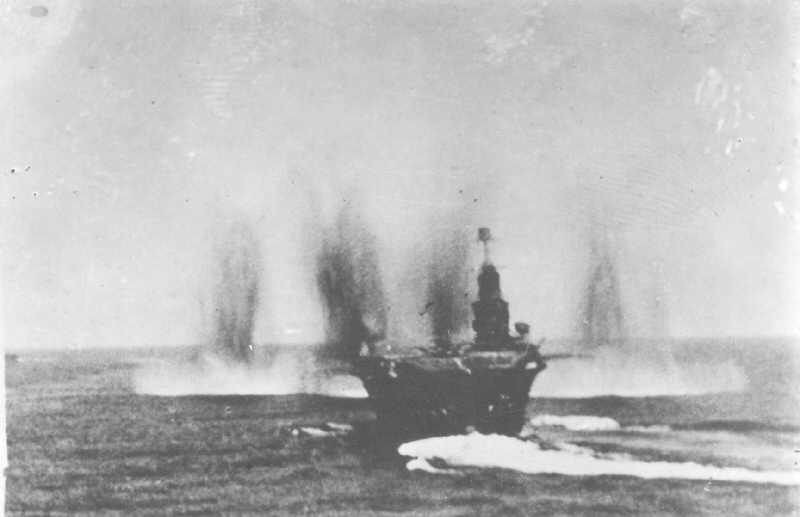
Written on the back
of this photo - HMS Illustrious
"going through it" on voyage to Malta January 1941.
Photo courtesy of Michael Longyear
|

